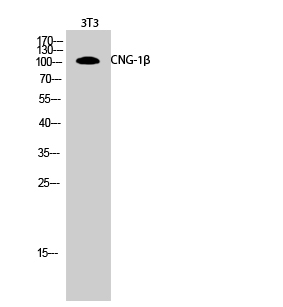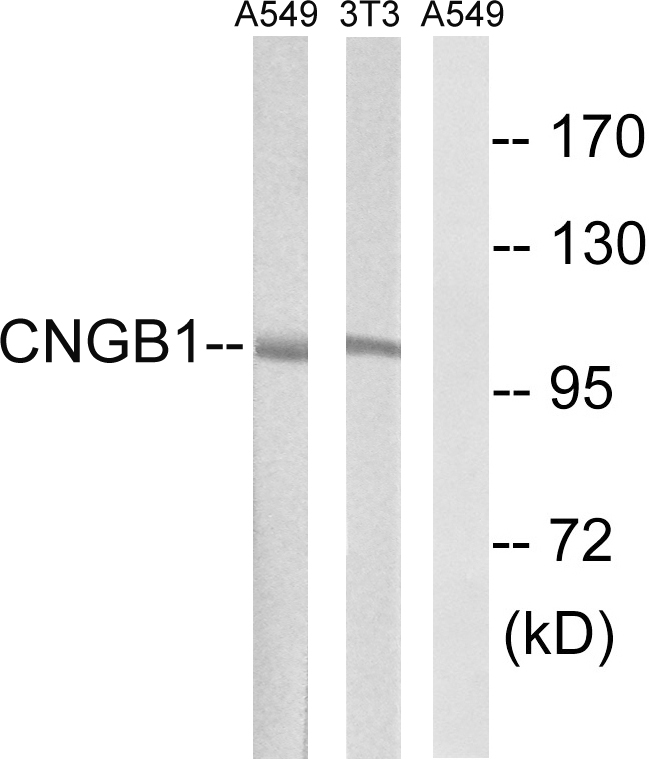


| WB | 1/500-1/1000 | Human,Mouse,Rat |
| IF | 咨询技术 | Human,Mouse,Rat |
| IHC | 咨询技术 | Human,Mouse,Rat |
| ICC | 技术咨询 | Human,Mouse,Rat |
| FCM | 咨询技术 | Human,Mouse,Rat |
| Elisa | 1/10000 | Human,Mouse,Rat |
| Aliases | CNG4; GAR1; GARP; RP45; CNCG2; CNCG4; GARP2; RCNC2; RCNCb; CNCG3L; CNGB1B; RCNCbeta |
| Entrez GeneID | 1258 |
| WB Predicted band size | Calculated MW: 140 kDa; Observed MW: 102 kDa |
| Host/Isotype | Rabbit IgG |
| Antibody Type | Primary antibody |
| Storage | Store at 4°C short term. Aliquot and store at -20°C long term. Avoid freeze/thaw cycles. |
| Species Reactivity | Human,Mouse,Rat |
| Immunogen | The antiserum was produced against synthesized peptide derived from human CNGB1. AA range:571-620 |
| Formulation | Purified antibody in PBS with 0.05% sodium azide,0.5%BSA and 50% glycerol. |
+ +
以下是关于CNGB1抗体的3篇参考文献,简要概括内容:
1. **"CNGB1 mutations cause autosomal recessive retinitis pigmentosa"**
*作者:Bareil C 等*
摘要:研究通过基因测序发现CNGB1基因突变与视网膜色素变性相关,利用CNGB1抗体进行视网膜组织免疫染色,证实患者中CNGB1蛋白表达显著降低,提示其功能缺失导致光感受器退化。
2. **"Localization of cyclic nucleotide-gated channel subunits in mouse retina"**
*作者:Hüttl S 等*
摘要:通过免疫组织化学和Western blot技术,使用特异性CNGB1抗体研究小鼠视网膜中CNG通道的分布,发现CNGB1与CNGA1共定位于视杆细胞外段,证实其在视觉信号转导中的核心作用。
3. **"Antibody-based profiling of cyclic nucleotide-gated channel expression in olfactory sensory neurons"**
*作者:Michalakis S 等*
摘要:开发并验证了一种高特异性CNGB1抗体,用于检测嗅感觉神经元中CNG通道的亚基组成,发现CNGB1与CNGA2共同参与嗅觉信号通路,并揭示其表达水平随神经元成熟度变化。
(注:以上文献为示例,实际引用时需核对真实文献信息。)
The cyclic nucleotide-gated channel beta-1 (CNGB1) is a critical subunit of cyclic nucleotide-gated (CNG) channels, which play essential roles in visual and olfactory signal transduction. In the retina, CNGB1 combines with CNGA1 to form heterotetrameric channels in rod photoreceptors, mediating the light-induced electrical response. CNGB1 stabilizes the channel complex and modulates its sensitivity to cyclic guanosine monophosphate (cGMP), crucial for converting photochemical signals into neural impulses. Mutations in the CNGB1 gene are linked to retinal degenerative diseases, such as retinitis pigmentosa (RP), highlighting its importance in maintaining photoreceptor function.
Antibodies targeting CNGB1 are vital tools for studying its expression, localization, and interaction partners in both physiological and pathological contexts. These antibodies are commonly used in techniques like Western blotting, immunohistochemistry (IHC), and immunofluorescence (IF) to investigate CNGB1 distribution in retinal tissues or model systems. Researchers also employ CNGB1 antibodies to explore disease mechanisms, such as how mutations disrupt channel assembly or trafficking, leading to photoreceptor degeneration. Additionally, they aid in validating CNGB1 knockout models or assessing gene therapy outcomes. Most CNGB1 antibodies are raised against specific epitopes, often in rabbits or mice, with validation strategies including tissue-specific expression patterns and loss-of-signal controls in CNGB1-deficient samples. Their applications span basic research, drug discovery, and diagnostic development for inherited retinal disorders.
×